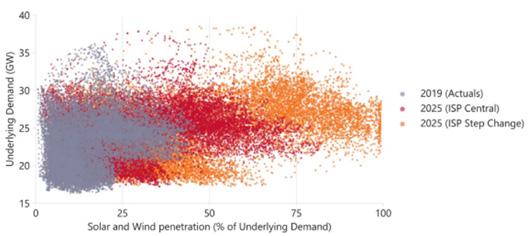COVID-19 AND CHANGES TO THE DESIGN OF THE NEM Dr Kerry Schott AO | Chair, Energy Security Board
Prior to COVID-19, the National Electricity Market (NEM) was experiencing a major transition as large and small-scale renewable generation entered the market in significant volumes. In response to this significant increase in variable renewables, the Energy Security Board was tasked by the then COAG Energy Council to recommend changes to the design of the NEM. These changes were to accommodate increasing renewable generation while maintaining reliability, security and affordability. The scale of growth in renewables that is expected is set out in Figure 1 below. At present, the NEM sometimes runs with 25 to 30 per cent variable renewables. By 2025 the ESB expects this may be closer to 50 per cent. Figure 1 Instantaneous penetration of wind and solar generation, actual in 2019 and forecast for 2025
THE PROBLEM WITH THE DESIGN OF THE NEM Because of the recent changes in the industry, the design of the NEM is no longer fit-for-purpose. The existing design developed market-based mechanisms and coordinated regulation of monopoly networks across the jurisdictions. In 1998, the NEM brought together the electricity industries in Queensland, New South Wales, the Australian Capital Territory, Victoria, South Australia and Tasmania. It was designed to drive greater efficiencies and better utilisation of resources and has served the nation well until the past decade. Initially the NEM design was characterised by: • relatively few large thermal generating units • an established transmission network to take that generation to the load (mainly in the cities), and • distribution networks that were one directional and where customers interacted with their energy retailer or local network in a very limited way. This market context and existing technology drove the key design choices for the NEM:
Source: AEMO, Integrated System Plan, 2020. Central scenario and Step Change scenario
The need to redesign the NEM continues despite COVID-19 – and if anything has intensified. This is due to the economic impacts of COVID-19. Retail revenue is down significantly as customers struggle to meet their bill payments and disconnection to manage this risk is neither a moral or regulatory permitted option. Revenue from generation is also down for two reasons. First, most business customers have cut back their operations and working from home has not replaced that demand. Second, the wholesale electricity price has fallen, partly in response to the entry of so much low-cost renewable power into the NEM.
PA R TN E R S H IP S 2 0 2 0
• energy-only spot market with significant constraints through the market price cap, price floor, and cumulative price threshold • open connection access to networks for generators • monopoly regulated networks • contracting and spot markets to link physical needs of the system to financial interests of participants, and • a limited market for a small number of ancillary services to keep the system in a secure operating state.
17










